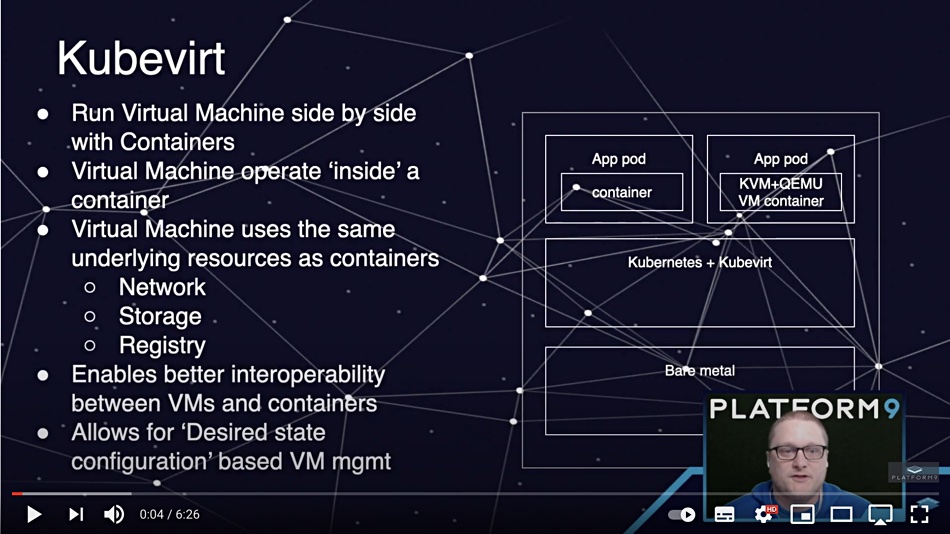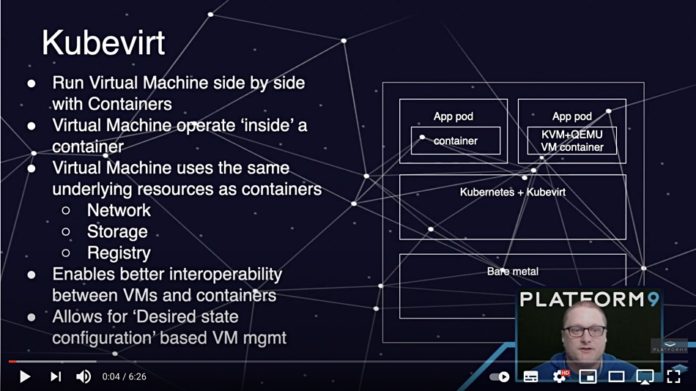Managed service provider Platform9 has announced that its open-source KubeVirt software can run containers and virtual machines together, using Kubernetes as the orchestration tool.
Update: Hypervisor requirement clarified, 16 July 2021.
Unlike VMware’s Tanzu initiative, which runs containers and VMs together inside a vSphere hypervisor envelope, KubeVirt runs its containers and VMs on a bare metal server with no hypervisor siphoning off CPU cycles.
Madhura Maskasky, VP of Product at Platform9, issued a statement which said: “Traditional virtualization solutions are expensive, and managing a virtualization stack in addition to Kubernetes is complex and error-prone.
KubeVirt obviates the need for developers to port all their applications to containers or manage two entirely separate stacks. Because it is open-source there is no vendor lock-in.”

KubeVirt is a virtual machine management add-on to Kubernetes and uses KVM within a Kubernetes container. The project was initiated by Red Hat for OpenShift, and then became a CNCF sandbox project. Platform9 offers a cloud-managed Kubernetes service and has now added a Managed KubeVirt service.
KubeVirt VMs are created in Platform9 Managed Kubernetes (PMK) clusters and can be managed using the same centralised SaaS management plane. They use the same underlying resources as containers — meaning networking, storage and a registry. A Containerised Data Importer (CDI) utility can be used to import, upload and clone Virtual Machine images.
Feature speeds and feeds
PMK has:
- Cloud-managed upgrades;
- Automated monitoring for VMs using built-in per cluster Prometheus instance;
- SR-IOV and OVS-DPDK support for performance-sensitive applications;
- SaaS console for VM operations;
- VM management capabilities like Image management, Preset management, and Snapshot management;
- Role-based access control, multi-tenancy, and resource utilisation quotas;
- Bare metal performance because it doesn’t run on top of a hypervisor;
- Guaranteed 99.9 per cent uptime SLA through shared visibility, governance, and control across thousands of locations.
Platform9 says its KubeVirt is good for telcos and 5G customers because it has another set of features:
- IPv6 support for all native services and users’ Kubernetes clusters;
- API-driven automated IP address management (IPAM);
- Multiple high-performance networking options — SR-IOV, DPDK, PCI-passthrough, MACvLan, and IPvLAN;
- Fully-managed Kubernetes operator to automate the configuration of a host, its physical network, and all necessary Kubernetes components, without the need to access the host;
- Advanced pod scheduling and deterministic performance with CPU-pinning, NUMA-aware scheduling, HugePages, Topology Manager, and CPU manager.
It says it has a team of Certified Kubernetes Administrators with a consistent CSAT rating of 99.9 per cent available 24×7.
Here we have a Kubernetes supplier providing competition to Robin.io in the 5G market.

You can find out more by studying a Platform9 KubeVirt white paper, watching a video, and reading a blog.
Update
Mallik Mahalingam, Cisco-acquired Springpath founder and now VP/Fellow at Intuit, tweeted: “KubeVirt needs hypervisor and it uses KVM to run VMs. We identified its potential for HX (Cisco HyperFlex) in 2019 as a way to use K8S for supporting both VMs and containers.”








